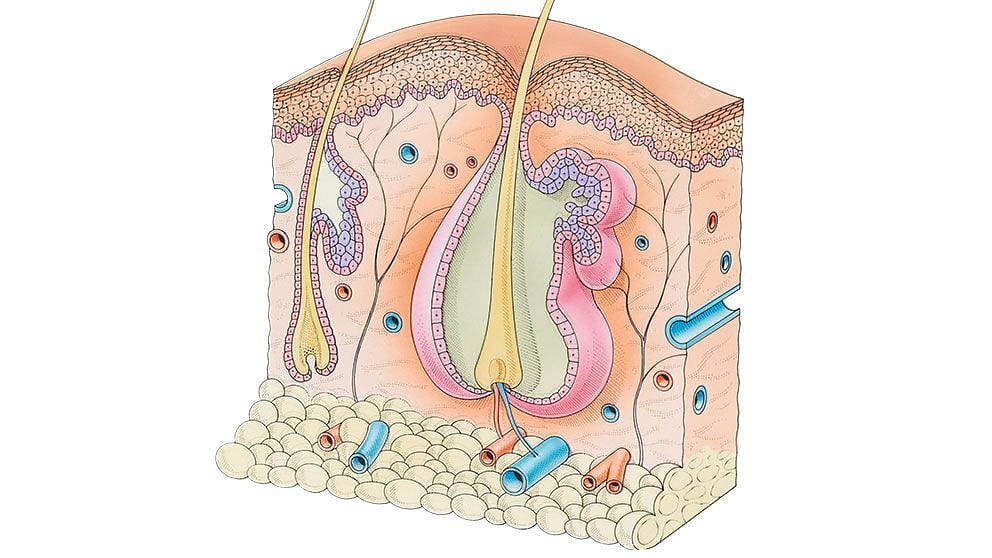Anatomic, putem distinge trei straturi ale pielii: Stratul cel mai exterior (epiderma), stratul interior cu glandele și nervii săi (derma) și stratul cel mai interior (hipoderma), care este compus în principal din celule grase.
Bariera noastră protectoare
Respiră, simte și se regenerează. Pielea nu este doar cel mai mare organ senzorial al nostru, ci și unul dintre cele mai multifațetate organe umane, atât la nivel fizic, cât și emoțional. Am adunat mai jos câteva date interesante.
Ne protejează corpul împotriva influențelor mediului și îl izolează de lumea exterioară. Este responsabilă de reglarea noastră termică. De asemenea, este un „avanpost” important al sistemului nostru imunitar pentru a ne feri de agenții patogeni. Pielea este foarte vie și este în continuă schimbare. Metabolismul său există într-un schimb intens de lichide și gaze (respirația pielii) și poate reacționa foarte sensibil la influențele fizice și emoționale. Pielea noastră este în multe feluri asociată cu lumea noastră emoțională interioară. Fiind cel mai mare organ senzorial al nostru, ea lucrează cu o rețea de celule senzoriale extrem de specializate distribuite în întregul corp pentru a constitui baza percepției temperaturii, a atingerii și a durerii. În același timp, ne scoate la suprafață stările emoționale interioare și ne dezvăluie sentimentele, de exemplu atunci când roșim sau devenim palizi.
Pielea ca organ senzorial
Pielea are multe funcții și este implicată în numeroase procese din organism. De o importanță deosebită este funcția sa de organ senzorial. Putem distinge între trei grupuri principale de percepții senzoriale care sunt foarte rafinate la om. Acestea sunt:
- Simțul termic, care ne permite să percepem temperatura din jurul nostru și să o comparăm cu propria noastră temperatură. Simțul termic servește la menținerea temperaturii corpului nostru și, de asemenea, ne ajută să ne protejăm împotriva degerăturilor și arsurilor. Temperatura corpului nostru ne afectează, de asemenea, bunăstarea fizică.
- Simțurile noastre tactile, pe care le folosim pentru a percepe atingerea, presiunea și vibrațiile.
- Receptorii durerii, care ne permit să percepem leziunile tisulare iminente sau deja apărute din cauza unor influențe externe (cum ar fi leziunile) sau din interior (cum ar fi inflamațiile).
2
1,5 până la 2 m² suprafață totală
4
3 până la 4 kg greutate totală
20
km de vase de sânge
3
săptămâni pentru a reînnoi straturile superioare ale celulelor
300000
glande sebacee
2
milioane de glande sudoripare
60
milioane de terminații nervoase
60
miliarde de celule
Oglinda sufletului
Reacțiile de zi cu zi, cum ar fi pălirea de frică și spaimă sau înroșirea de rușine, jenă și alte emoții, arată importanța pielii ca oglindă a sufletului. Stimulii externi ne pot influența starea emoțională de spirit. În funcție de cât de sensibili suntem, senzațiile de frig și căldură, presiune și durere ne pot afecta în moduri diferite. Pielea și sufletul nostru sunt intim legate. Multe boli de piele pot duce la probleme de sănătate mintală sau stres. Invers, multe boli de piele au un fundal psihosomatic. În medicina antroposofică, căutăm să dobândim o înțelegere mai profundă a bolilor. O atenție deosebită este acordată relației dintre piele și procesele fizice, precum și cele emoționale.
© Skin cross-section Getty Images
Toate cifrele sunt aproximative.
Dr. Frank Meyer
General Physician
Dr. Mayer is specialised in Anthroposophic Medicine and is an expert on Holistic Medicine. He lives and works in Nuremberg, Germany.







